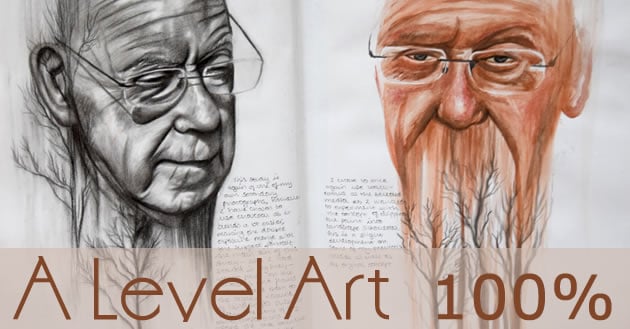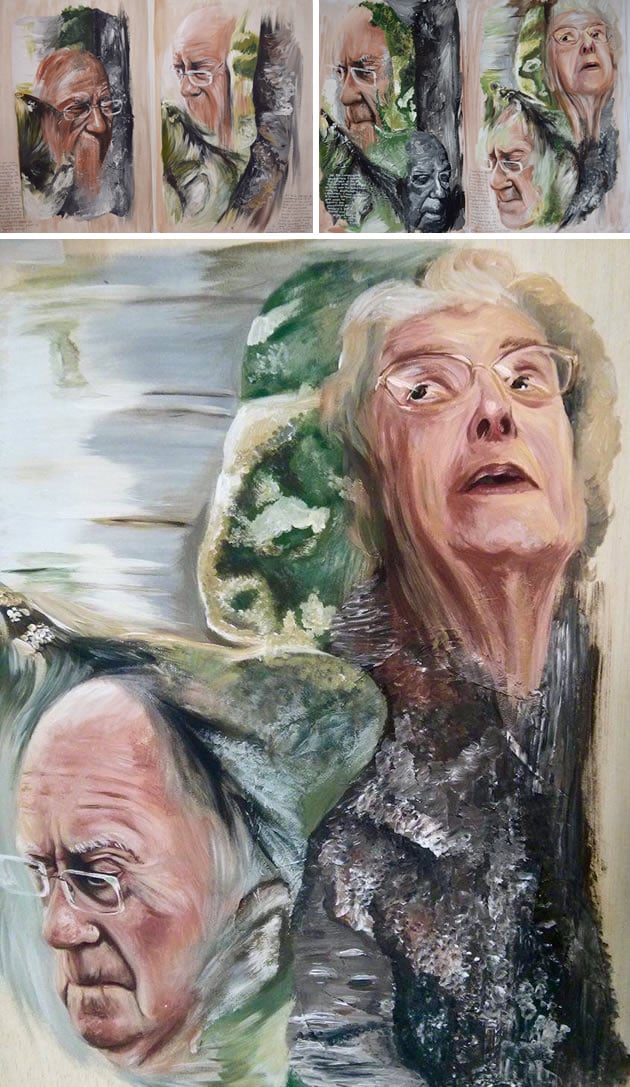How to be successful and enjoy your A Level Art Exam
Final Updated on January 5, 2022
Emily Fielding gained 100% for A Level Art Edexcel, while studying at Kennet School, Berkshire, England (2014). Emily shares tips and advice for students who are sitting the A2 Art exam.
Some of Emily's sketchbook pages are included in our new book: Outstanding High School Sketchbooks . This volume has high-resolution images and so that fine details and annotation are clear, making it an excellent resource for students and schools. Larn more than!


The inevitable exam season speedily falls upon students, as the pressure heats upwards in your final twelvemonth of A Levels. The exam newspaper is released and the dreaded brusk fourth dimension-frame to produce your project can experience like only five minutes! Simply, at that place are ways to brand the most of this examination – to show off your skill and potential, also equally turning it into a project that you actually enjoy.

As always, themes can vary. Virtually of the time, in the final year of A Level Art, your test is a chance to prove off what you can do without many restrictions. So why not select a theme that actually interests you? It seems like a simple and obvious tip, simply it is surprising how many people try to push projects in a direction that is ambiguous. This uncertainty tin mean struggling to create a good projection. For my A2 Art test, I was given an exam newspaper with the title 'Flaws, Perfection, Ideals and Compromises'. My teacher suggested just focusing on one of these titles, or – at a stretch – even two, if they worked well together. 'Flaws' and 'perfection' were the ones that stood out to me, as I began to brainstorm ideas. Whatever brainstorming or thinking processes that you lot go through to make a decision well-nigh your project tin can be recorded – you lot may even turn this task into a drawing itself (come across examples of creative mind maps). One matter that I would as well suggest, before settling upon a definite theme, is to spend a day or ii doing in-depth enquiry of some artists, and so that you have a proficient idea of the directions that you could take your project.
Enquiry is a massive part of whatever Art project, particularly in an exam. An important function of your research is observational studies, related to your theme. A big fault that some students make is sticking to just one form of media because they consider this to be their strongest skill. Yes, yous bear witness off your talents – only risk taking is advantageous. This is a bang-up opportunity to improve your skill set and become more confident in dissimilar areas of fine art. If you want to show off, say, your ability with pencils – so do information technology! Only simply don't forget about other mediums that want some attention in your project.
Then comes the artist research! Make sure you have thoroughly thought about why you want to select certain artists (and explain this in your note). It is all very well with their work having a articulate link to your theme, but if you can't interpret it into your ain way and develop ideas from this, and so stay clear of researching them. There is cypher worse than hit a wall when information technology comes to responding to an artist! Information technology may be helpful to research 3 or four artists throughout the whole exam (I personally conducted 3 in this examination, as I was enlightened of the brusk time frame and what I felt was doable). In terms of the layout of my exam preparation, I analysed three artists in one chunk, then moved on to doing development and personal response. I felt this was the easiest way of going about it. Artist responses can take up a lot of time and I didn't want to reduce the quality of my research past rushing through information technology.
Before I began my artist response, I completed an creative person comparing. I made a simple Venn diagram, in which I wrote information about each artist – methods, materials, subject matter etc. It was a clear way for me to beginning thinking about how I could create my own compositions using each of their styles, just it again created a articulate line of thought to present to the teacher/examiner.

My selected artists for this exam project were: Sophie de Oliviera Barata – a 3D sculptor who creates artistic fake limbs, Jenny Morgan – a painter who builds up and removes layers of her portraits and Annemarie Busschers – who composes portraits upon unusual backgrounds, such equally wood. I actually wanted to push my ain skill level as well as encourage experimentation and hazard/taking – I knew this would brand my project more successful, plus I was lucky plenty to have the materials available to me at my school to make this a reality. I put aside one week at the starting time of my project to consummate this creative person research (setting goals is a great way to make sure you become things done). Personally, I thoroughly enjoyed creating research pages for this project, every bit well every bit creating a report of each artist's piece of work (this helped to give me an agreement to the process they go through).

To assist show 'context' in my A Level exam project, I referenced specific historical painting methods and movements such equally 'underpainting' and Surrealism. Introducing a piddling bit of history helps to bring an academic chemical element to your projection, expressing non only your talent with Art, but your knowledge of the field of study.
I recall it can be quite piece of cake to let the stress of the examination and express time-frame go to you, which is when you finish enjoying your project. 1 tip that I kept reminding myself of was – 'how can I make this page in my book more than exciting?' I wanted to have a project that I loved and looked at with fondness when I flicked through the pages. More than times than not, if you honey and are confident of your own piece of work, so will your teachers, examiners and others. Endeavour using this in your own work and you will be surprised with the improvement it makes in your presentation.
I so began the section of my project where I responded to the artists and developed my own compositions. I began by creating some more observational studies – both first-hand as well from my own photographs. I conducted some of my own photo-shoots in relation to each artist, which shows independent research in contrast to always relying on Google! I experimented with using my own photographs and creating compositions mimicking the style of the artists, also creating a larger scale piece for each creative person (three in total). This again shows a willingness to push your personal comfort zone every bit well as being able to manage your time effectively. At the terminate of each creative person response, I also wrote a short review, linking dorsum to my initial project brief and discussing what I was thinking of doing side by side.

Once I created my initial responses, I began experimenting with materials, developing my ideas towards my last composition. I spent time transforming my favourite drawings/paintings using gesso, screen press, embroidery, h2o colours, charcoal, newspaper mache, painting on top of tissue newspaper and wood, impasto and even alginate which I used to brand a bandage of a hand. If you are really struggling with coming up with an idea for a limerick, experimenting with loads of different materials volition assistance give you ideas that you would have never have thought of otherwise.

Afterward I had experimented with my images, I began to know which images were my favourite and what I wanted to include in my final composition. I began to aggrandize my idea by because what background I wanted to utilize likewise as thinking almost how information technology could link back to my artist research. I experimented with texture, lighting and, of course, how a portrait could merge into the background. Each step I recorded, to show the evolution of ideas.

Finally, one last thing: annotation. Talk over the materials you lot used, the composition, the method, the emotion behind the image, the colours, if it worked out how you wanted, mistakes, everything. The more, the amend. It shows you sympathize what you lot are doing and want to do to better and develop. Reflection is just as of import as your art skills!
Emily'southward A Level Art test can be viewed in its entirety in the following video:
Some of Emily'south sketchbook pages are included in our upcoming publication: 100 Loftier School Sketchbooks. You lot may likewise be interested in her 100% A Level Art Coursework project!

This article was written by Emily Fielding. Emily gained 100% (full marks) in GCSE Fine art & Blueprint, A Level Art & Blueprint and A Level Photography. She currently studies make-up and prosthetics for film/tv at the University of Arts London (UAL) and has over 22,000 subscribers on Youtube.
Source: https://www.studentartguide.com/featured/enjoy-a-level-art-exam
0 Response to "How to be successful and enjoy your A Level Art Exam"
Post a Comment